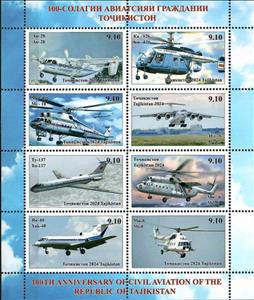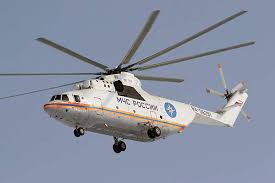Mini Sheet: Civil Aviation in Tajikistan, Centenary (Tajikistan 2025)
Civil Aviation in Tajikistan, Centenary (Tajikistan 2025)
01 January (Tajikistan ) within release Civil Aviation in Tajikistan, Centenary (2025) goes into circulation Mini Sheet Civil Aviation in Tajikistan, Centenary face value 8*9.10 Tajikistani somoni
| Mini Sheet Civil Aviation in Tajikistan, Centenary in catalogues | |
|---|---|
| Colnect codes: | Col: TJ 2025.00.00-12 |
Mini Sheet is square format.
Dated 2024Also in the issue Civil Aviation in Tajikistan, Centenary (2025):
- Stamp - An-28 face value 9.10;
- Mini Sheet - Civil Aviation in Tajikistan, Centenary face value 8*9.10;
- Stamp - Il-76 face value 9.10;
- Stamp - Ka-126 Helicopter face value 9.10;
- Stamp - Mi-10 Helicopter face value 9.10;
- Stamp - Mi-6 Helicopter face value 9.10;
- Stamp - Mi-8 Helicopter face value 9.10;
- Stamp - Tu-137 face value 9.10;
- Stamp - Yak-40 face value 9.10;
Mini Sheet Civil Aviation in Tajikistan, Centenary it reflects the thematic directions:
An aircraft (pl. aircraft) is a vehicle that is able to fly by gaining support from the air. It counters the force of gravity by using either static lift or the dynamic lift of an airfoil, or, in a few cases, direct downward thrust from its engines. Common examples of aircraft include airplanes, rotorcraft (including helicopters), airships (including blimps), gliders, paramotors, and hot air balloons.Part 1 (Definitions and Abbreviations) of Subchapter A of Chapter I of Title 14 of the U. S. Code of Federal Regulations states that aircraft "means a device that is used or intended to be used for flight in the air."
Aviation is the practical aspect or art of aeronautics, being the design, development, production, operation and use of aircraft, especially heavier than air aircraft. The word aviation was coined by French writer and former naval officer Gabriel La Landelle in 1863, from the verb avier (synonymous flying), itself derived from the Latin word avis ("bird") and the suffix -ation.
A helicopter is a type of rotorcraft in which lift and thrust are supplied by horizontally spinning rotors. This allows the helicopter to take off and land vertically, to hover, and to fly forward, backward and laterally. These attributes allow helicopters to be used in congested or isolated areas where fixed-wing aircraft and many forms of short take-off and landing (STOL) or short take-off and vertical landing (STOVL) aircraft cannot perform without a runway.



